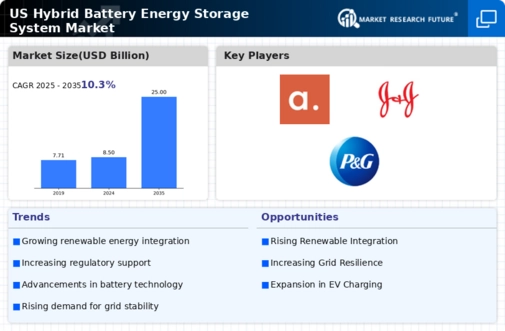Rising Demand for Renewable Energy
The increasing demand for renewable energy sources in the US is a primary driver for the hybrid battery-energy-storage-system market. As more states implement renewable energy mandates, the need for efficient energy storage solutions becomes critical. The hybrid systems can store excess energy generated from solar and wind sources, ensuring a reliable power supply. According to the US Energy Information Administration, renewable energy accounted for approximately 20% of total electricity generation in 2023, and this figure is expected to rise. This trend indicates a growing market for hybrid battery-energy-storage-systems, as they facilitate the integration of renewable sources into the grid, thereby enhancing energy security and sustainability.
Growing Electrification of Transportation
The electrification of transportation is a notable driver for the hybrid battery-energy-storage-system market. With the US government promoting electric vehicles (EVs) through incentives and infrastructure development, the demand for efficient energy storage solutions is likely to increase. Hybrid systems can play a crucial role in supporting EV charging stations, providing the necessary energy during peak demand periods. The US Department of Energy has projected that by 2030, EVs could account for up to 30% of new vehicle sales. This shift towards electrification not only supports the hybrid battery-energy-storage-system market but also aligns with broader sustainability goals, creating a synergistic effect that enhances market growth.
Supportive Policy Frameworks and Incentives
Supportive policy frameworks and incentives are crucial drivers for the hybrid battery-energy-storage-system market. Federal and state governments in the US are implementing various policies to promote energy storage adoption, including tax credits, grants, and regulatory reforms. These initiatives aim to reduce the financial barriers associated with energy storage technologies, encouraging investment and deployment. For instance, the Investment Tax Credit (ITC) allows for a significant reduction in upfront costs for energy storage systems. As these policies gain traction, they are expected to stimulate market growth, making hybrid battery-energy-storage-systems more appealing to consumers and businesses alike.
Technological Innovations in Energy Storage
Technological innovations are reshaping the hybrid battery-energy-storage-system market, driving efficiency and performance improvements. Advances in battery chemistry, such as lithium-sulfur and solid-state batteries, are enhancing energy density and lifespan, making hybrid systems more attractive. Furthermore, the integration of artificial intelligence and machine learning in energy management systems is optimizing the operation of hybrid storage solutions. These innovations are expected to reduce costs and improve reliability, making hybrid systems more accessible to a broader range of consumers and businesses. As technology continues to evolve, the hybrid battery-energy-storage-system market is likely to experience accelerated growth, driven by enhanced capabilities and performance.
Increased Investment in Energy Storage Technologies
Investment in energy storage technologies is surging, significantly impacting the hybrid battery-energy-storage-system market. In 2023, investments in energy storage reached approximately $5 billion in the US, reflecting a robust interest from both private and public sectors. This influx of capital is likely to accelerate the development and deployment of advanced hybrid systems, which combine various storage technologies to optimize performance. The financial backing is essential for research and development, enabling innovations that improve efficiency and reduce costs. As the market matures, these investments are expected to yield more competitive pricing and enhanced capabilities, further driving adoption across various sectors.













Leave a Comment